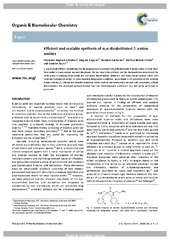Blar i forfatter Det helsevitenskapelige fakultet "Ausbacher, Dominik"
-
Amphipathic barbiturates as marine product mimics with cytolytic and immunogenic effects on head and neck squamous cell carcinoma cell lines
von Hofsten, Susannah; Langer, Manuel K; Korelin, Katja; Norvoll Magnussen, Synnøve; Ausbacher, Dominik; Anderssen, Trude; Salo, Tuula; Strøm, Morten B.; Bayer, Annette; Al-Samadi, Ahmed; Berge, gerd (Journal article; Tidsskriftartikkel; Peer reviewed, 2023-03-30)The incidence of head and neck squamous cell carcinoma (HNSCC) is increasing and the conventional treatments for this form of cancer can be tough. Despite the success of existing immunotherapies in some HNSCC patients, many do not respond to this type of treatment. Thus, the development of novel anti-cancer therapies should be prioritized. In the current study, the anticancer activity of a panel ... -
Amphipathic Barbiturates as Mimics of Antimicrobial Peptides and the Marine Natural Products Eusynstyelamides with Activity against Multi-resistant Clinical Isolates
Paulsen, Marianne Hagensen; Engqvist, Magnus; Ausbacher, Dominik; Anderssen, Trude; Langer, Manuel Karl; Haug, Tor; Morello, Glenn Robert; Liikanen, Laura; Blencke, Hans-Matti; Isaksson, Johan; Juskewitz, Eric; Bayer, Annette; Strøm, Morten B. (Journal article; Tidsskriftartikkel; Peer reviewed, 2021-07-27)We report a series of synthetic cationic amphipathic barbiturates inspired by the pharmacophore model of small antimicrobial peptides (AMPs) and the marine antimicrobials eusynstyelamides. These N,N′-dialkylated-5,5-disubstituted barbiturates consist of an achiral barbiturate scaffold with two cationic groups and two lipophilic side chains. Minimum inhibitory concentrations of 2–8 μg/mL were achieved ... -
Amphipathic β2,2-Amino Acid Derivatives Suppress Infectivity and Disrupt the Intracellular Replication Cycle of Chlamydia Pneumoniae
Hanski, Leena; Ausbacher, Dominik; Tiirola, Terttu; Strøm, Morten B.; Vuorela, Pia M. (Journal article; Tidsskriftartikkel; Peer reviewed, 2016-06-09)We demonstrate in the current work that small cationic antimicrobial β2,2-amino acid derivatives (Mw < 500 Da) are highly potent against Chlamydia pneumoniae at clinical relevant concentrations (< 5 μM, i.e. < 3.4 μg/mL). C. pneumoniae is an atypical respiratory pathogen associated with frequent treatment failures and persistent infections. This gram-negative bacterium has a biphasic life cycle ... -
Efficient and scalable synthesis of α,α-disubstituted β-amino amides
Paulsen, Marianne Hagensen; Engqvist, Magnus; Ausbacher, Dominik; Strøm, Morten Bøhmer; Bayer, Annette (Journal article; Tidsskriftartikkel; Peer reviewed, 2016-07-12)A practical and efficient methodology for the preparation of 2-aminoethyl α,α-disubstituted β-amino amides in three steps from methyl cyanoacetate has been developed. The key step in the synthesis was the chemoselective reduction of the nitrile group in presence of an amide and aryl halide functionalities. Reduction with RANEY® Nickel catalyst, either with molecular hydrogen (8–10 bar) or under ... -
The Marine Natural Product Mimic MHP88 Shows Anticancer Activity and has the Potential to Cause Immunogenic Cell Death
von Hofsten, Susannah; Norvoll Magnussen, Synnøve; Ausbacher, Dominik; Paulsen, Marianne Hagensen; Bayer, Annette; Strøm, Morten B.; Berge, Gerd (Conference object; Konferansebidrag, 2020-03)The marine natural product mimic MHP 88 is a novel synthetic molecule based on unique structures found in molecules from an arctic marine bryozoan. Initial studies showed that MHP88 kills cancer cells efficiently, but is not hemolytic. In this study, we look closer at the mode of death induced by MHP88 in oral cancer (HSC-3) and lymphoma (Ramos) cell lines. Immunogenic cell death (ICD) is a mode of ... -
The marine natural product mimic MPM-1 is cytolytic and induces DAMP release from human cancer cell lines
von Hofsten, Susannah; Paulsen, Marianne Hagensen; Magnussen, Synnøve; Ausbacher, Dominik; Kranz, Mathias; Bayer, Annette; Strøm, Morten Bøhmer; Berge, Gerd (Journal article; Tidsskriftartikkel; Peer reviewed, 2022-09-16)Bioprospecting contributes to the discovery of new molecules with anticancer properties. Compounds with cytolytic activity and the ability to induce immunogenic cell death can be administered as intratumoral injections with the aim to activate anti-tumor immune responses by causing the release of tumor antigens as well as damage-associated molecular patterns (DAMPs) from dying cancer cells. In ... -
Selective intracellular delivery of thiolated cargo to tumor and neovasculature cells using histidine-rich peptides as vectors
Eksteen, Jacobus Johannes; Ausbacher, Dominik; Vasskog, Terje; Rekdal, Øystein; Svendsen, John Sigurd Mjøen (Journal article; Tidsskriftartikkel; Peer reviewed, 2020-03-06)Short histidine-rich peptides could serve as novel activatable vectors for delivering cytotoxic payloads to tumor and neovasculature cells. This explorative study reports preliminary results showing that zinc ions, which are found in elevated levels at neovasculature sites, can trigger the intracellular delivery of a short antimicrobial peptide when conjugated to a histidine-rich peptide through a ... -
α,α-disubstituted β-amino amides eliminate Staphylococcus aureus biofilms by membrane disruption and biomass removal
Ausbacher, Dominik; Miller, Lindsey A.; Goeres, Darla M.; Stewart, Philip S.; Strøm, Morten Bøhmer; Fallarero, Adyary (Journal article; Tidsskriftartikkel; Peer reviewed, 2023-08-25)Bacterial biofilms account for up to 80% of all infections and complicate successful therapies due to their intrinsic tolerance to antibiotics. Biofilms also cause serious problems in the industrial sectors, for instance due to the deterioration of metals or microbial contamination of products. Efforts are put in finding novel strategies in both avoiding and fighting biofilms. Biofilm control is ...


 English
English norsk
norsk






